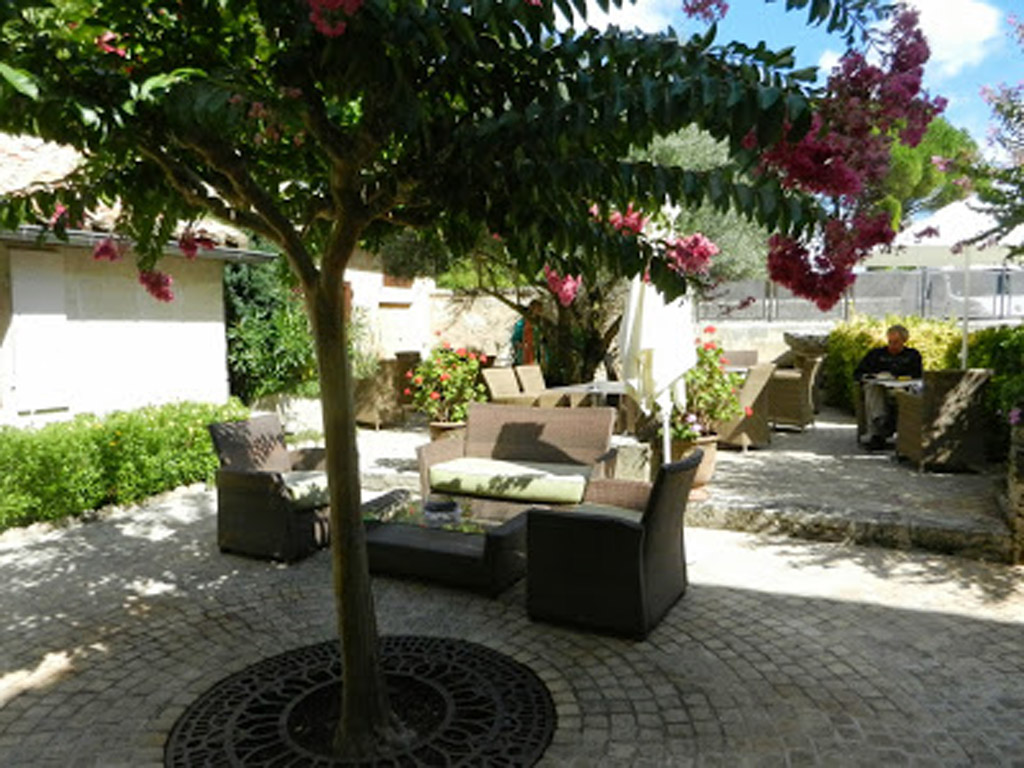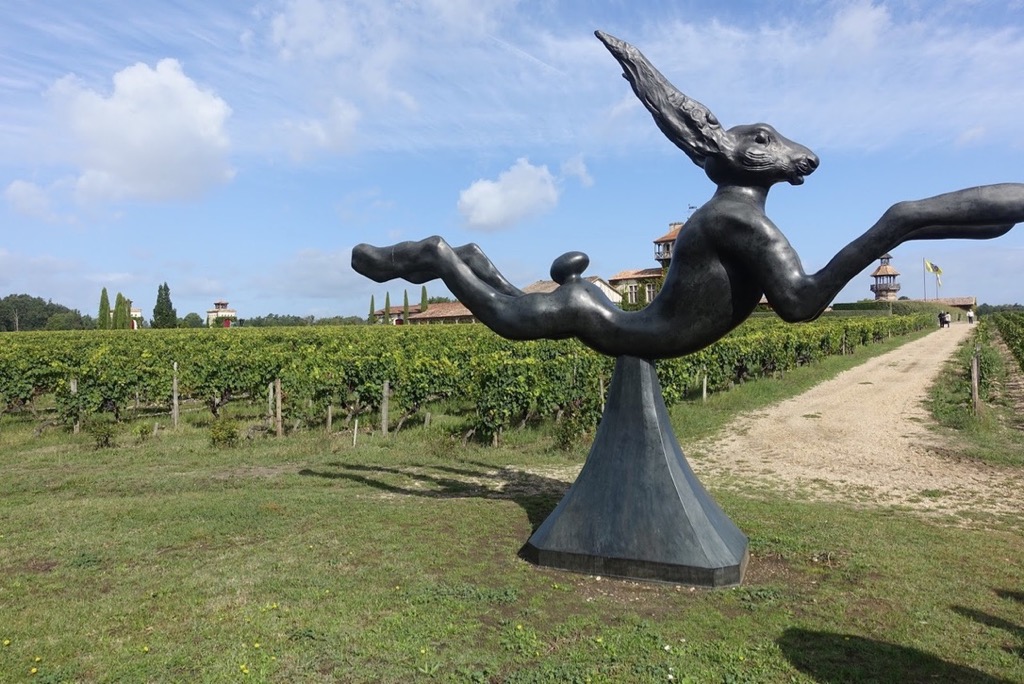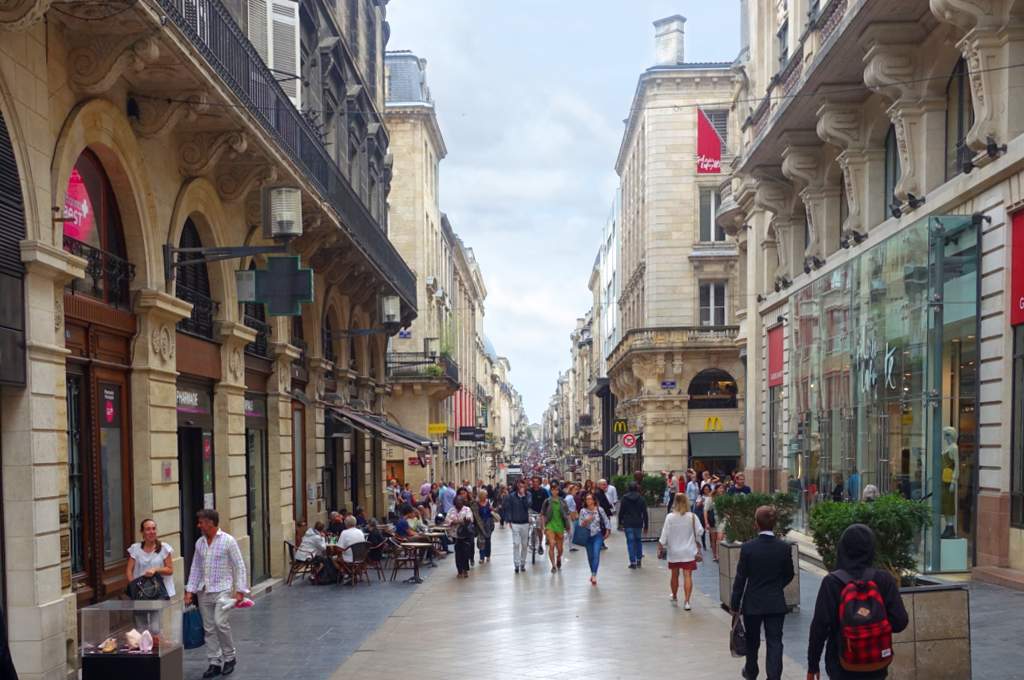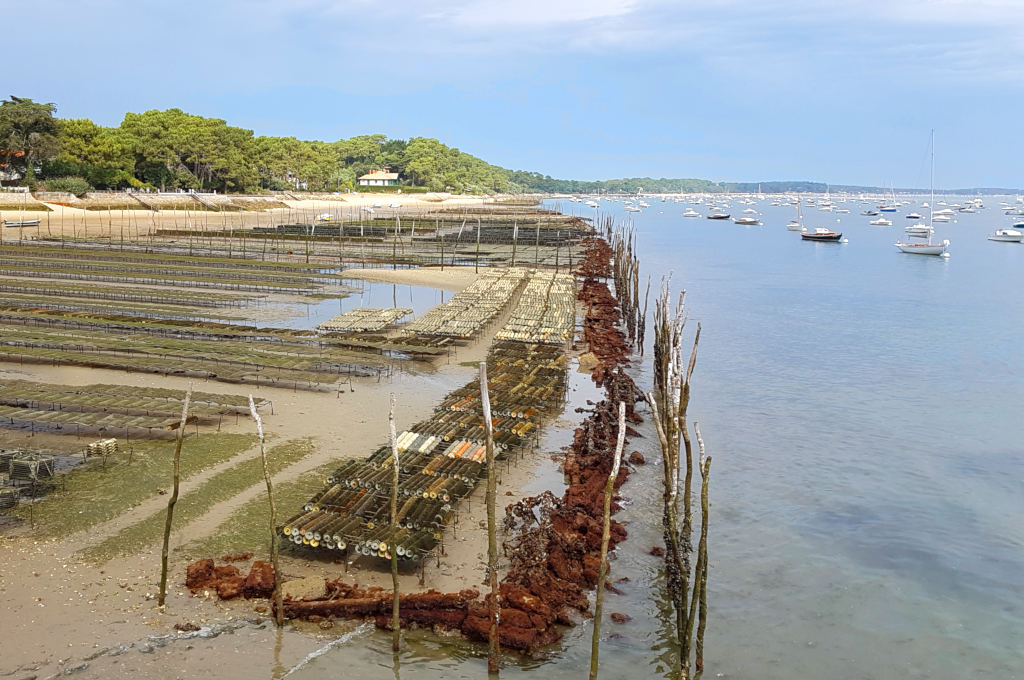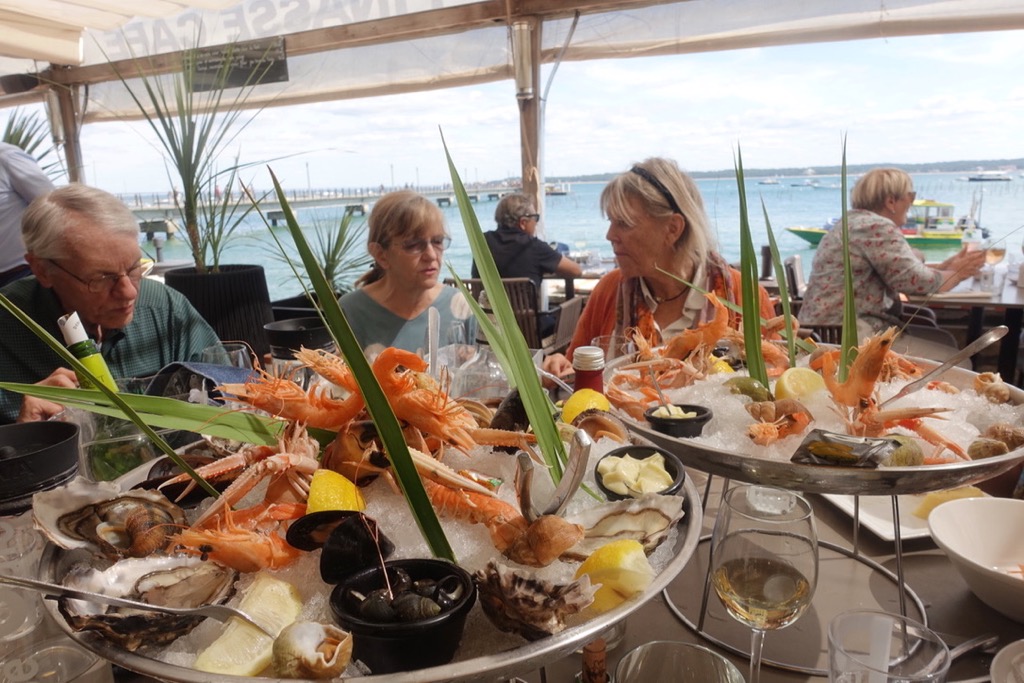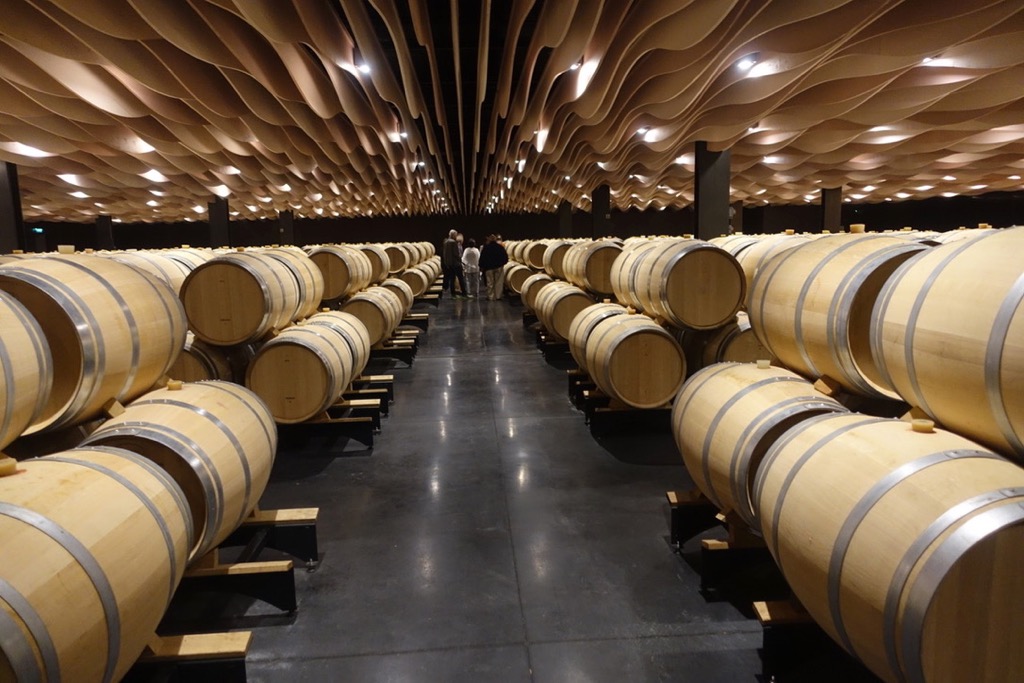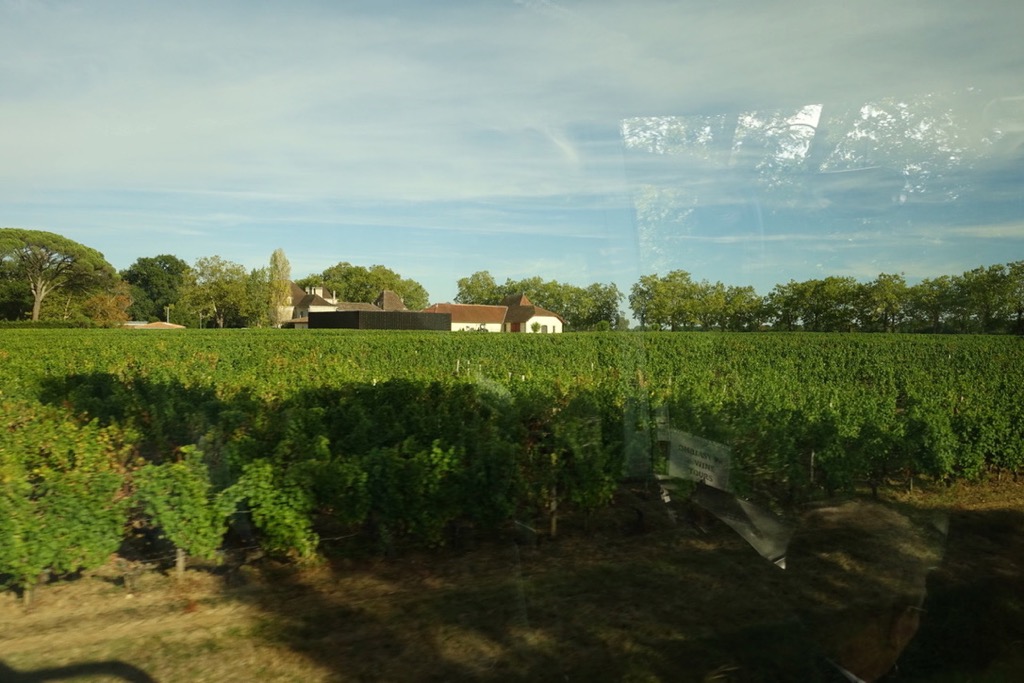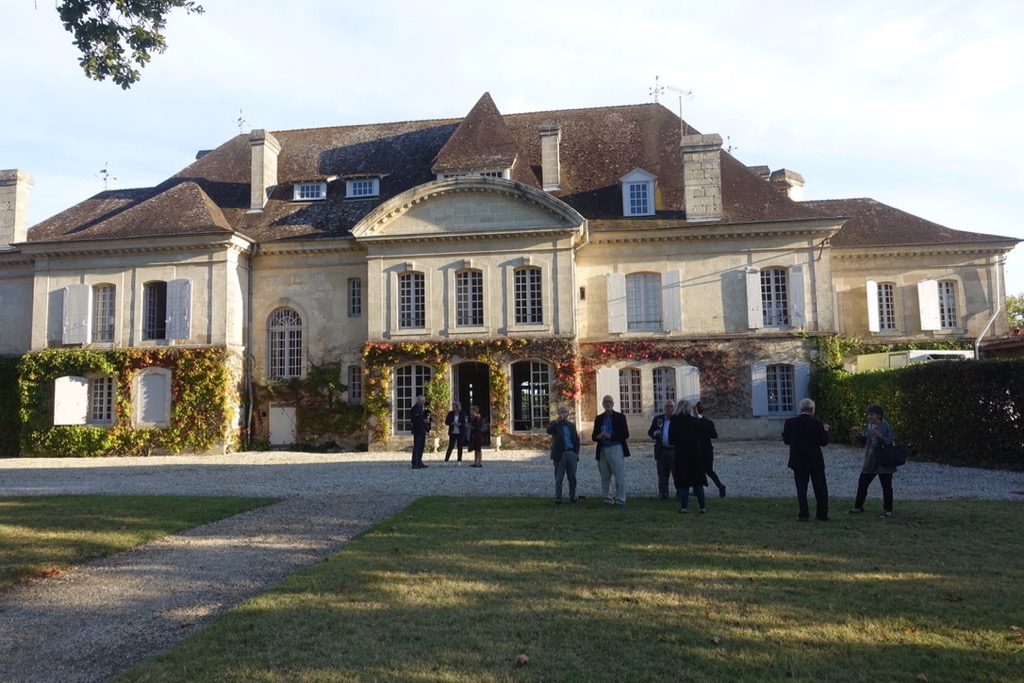Total Immersion in Bordeaux
The Wine and Culinary Tour: World Class Wines and Exquisite French Cuisi
10 Days: Tuesday, May 20 - Thursday, May 29, 2025
Accommodation: 9 nights:
Night 1: Tuesday, May 20Hôtel Hilton Garden Inn in Bordeaux, a more recently built (opened in July 2018), modern, very comfortable hotel with for French standards very spacious rooms overlooking the Garonne river and with a great fitness center in walking distance to the main train station of Bordeaux. |
Nights 2 + 3: Wednesday, May 21 and Thursday, May 22:Au Logis des Remparts in Saint-Emilion, a very charming, well tended historic 3+ star, upscale boutique hotel in the heart of UNESCO world heritage wine town Saint-Emilion with a stunning garden, beautiful views on the vineyards and a gorgeous outdoor pool. |
Nights 4 + 5: Friday, May 23 and Saturday, May 24:Hôtel Bayonne Etche-Ona in Bordeaux, a refinded 4+ star lodging in an 18th century mansion close to old town Bordeaux, in walking distance to all interesting places with highly comfortable rooms. |
Nights 6 + 7 + 8: Sunday, May 25 and Monday, May 26 and Tuesday, May 27:Hôtel Des Vignes et Des Anges, Premier Best Western, in Pauillac, a just completely renovated, exquisite 4 star hotel with outdoor pool in the heart of the Médoc region, right on the waterfront of the Gironde estuary. |
Night 9: Wednesday, May 28:Hôtel Hilton Garden Inn in Bordeaux. |
DAY 1: Tuesday, May 20Arrival in Bordeaux, check-in at Hôtel Hilton Garden Inn in Bordeaux. |
AFTERNOON
Welcome drink and introduction to the Bordeaux wine region in the Hôtel Hilton Garden Inn in Bordeaux city. |
Visit at Millésima in Bordeaux. Tour of the warehouse, lecture, and wine-cheese pairing.
This is a fitting introduction to “Bordeaux” and is to make your mouth watering of anticipation what lies ahead of you by looking at all the cases brimming with wines of the many chateaux we are going to visit. In Bordeaux the wine merchants have always played a decisive part in the wine world. The buying and selling of wine, the setting of a price of a bottle of wine from a specific chateau for a specific vintage, the entire conduct of business is described as „La Place de Bordeaux“. The wine trade in Bordeaux goes back many centuries to the time when Aquitaine was English. Since then, set rules that appear mysterious to the outsider have been in place. We will visit a Bordeaux lover’s paradise, the prominent wine merchant “Millésima” where over two million bottles of top Bordeaux wines are stored and waiting to be shipped. A stroll through the vast storage rooms feels like being a kid in a candy store. We will be introduced to the rules, regulations, and peculiarities of the “Place de Bordeaux“. My friend Manuela, who speaks an excellent English, is an expert. She will talk about the system “en primeur”, the role of the “courtier”, and she will prepare a cheese and wine pairing to discuss wines from different appellations. |
Winery tour and tasting at Château Pape-Clément, Graves, Appellation Pessac-Léognan, Cru Classé de Graves.
Planted with vines in the 13th century, the Château Pape-Clement is the oldest continuously operating wine estate in the entire Bordeaux region. Its name is derived from one of the heirs of the winery who later became Pope Clement V. and wrote history by moving the papacy to Avignon. Today Château Pape-Clement belongs to the wine imperium of Bernard Magrez, which now covers about 40 estates in Bordeaux and other parts of France as well as in the rest of the world. Château Pape-Clément is classified for its white and red wine according to the 1953 classification of the Graves. The red usually consists of 55% Cabernet-Sauvignon and 45% Merlot and is a full-bodied, presice wine with an incredible intensity. Although I am a true German white wine fan I very much enjoy the Pape-Clément white wine. The blend usually is 55 % Sauvignon-Blanc and 45 % Sémillion. This mediun-bodied wine is fresh, clean and minerally. About 20% of the blend is aged in concrete eggs. Winemaker Arnaud Lasisz will give us the tour and will guide us through the tasting. |
EVENINGDinner and wine at Restaurant L’Estacade in Bordeaux.
The restaurant literally sits on the Garonne river opposite of Bordeaux city center. The view on the illuminated Place de la Bourse is breathtaking and makes you fall in love with Bordeaux right away. |
DAY 2: Wednesday, May 21 |
MORNINGWinery tour and tasting at Château Canon-La-Gaffelière, Appellation Saint-Émilion, Premier Grand Cru Classé B.
Canon-La-Gaffelière belongs to the only 18 Premiers Grands Crus Classés châteaux in Saint-Emilion (4 Premiers Grands Crus Classés A and 14 Premiers Grands Crus Classés B). Château Canon La Gaffelière and La Mondotte –also owned by Count Stephan - were promoted to the extremely competitive circle of Premiers Grands Crus Classés of St. Émilion in the September 6, 2012 blind tasting. Proprietor Count Stephan von Neipperg is a descendant of a German noble line dating back to the Holy Roman Empire. Members of this dynasty always played important roles in European history and politics, and have been making wine since the 12th century. The family still owns a wine estate in the Württemberg region of Germany, where their roots are. In 2011 Stephan von Neipperg switched to ecological viticulture at his Saint-Émilion estates and the mixture of grape varieties cultivated on the Canon-La Gaffelière estate (55% Merlot, 40% Cabernet Franc and 5% Cabernet Sauvignon) is rather untypical in comparison to the rest of the appellation. This identity, strongly influenced by Cabernet, gives the Canon La Gaffelière wines a very complex character. |
Winery tour and tasting at Château Belles-Graves, Appellation Lalande de Pomerol |
LUNCHLunch (beverages on your own) at restaurant La Terrasse Rouge.
This restaurant sits on the roof-top of Château La Dominique, Appellation Saint-Emilion, Grands Crus Classés in Saint-Emilion. This is a fabulous look out point over the sea of vineyards of Saint-Émilion and Pomerol. |
AFTERNOONWinery tour and tasting at Château Gazin, Appellation Pomerol.
This is our first visit to the famous Pomerol wine region. Pomerol is a tiny winegrowing region, located on the pilgrim road to Santiago de Compostela. Wine has been produced here since Roman times. Later the Knights of the Order of Malta cultivated the vines. In the Middle Ages, these knights established the Commanderie de Pomerol, which still exists today. |
EVENINGCheck in at hotel Au Logis des Remparts in Saint-Emilion.
This hotel is a gem. The rooms are modern and very tastefully decorated. It also has a beautiful garden and quite a big pool. It provides for total peace, tranquility, and fresh air.
|
Cheese and charcuterie dinner and wine at Chai Pascal in Saint-Emilion. |
DAY 3: Thursday, May 22 |
MORNINGWinery tour and tasting at Château Clos Fourtet, Appellation Saint-Emilion, Premier Grand Cru Classé B.
The history of Château Clos Fourtet goes back as far as the Middle Ages, some even say to Roman times. A defensive settlement was built to protect the town of Saint-Emilion and at the site of Clos Fourtet a military camp was constructed. From the 17th to the 19th century what is now Clos Fourtet was known as Campfourtet. The first vines were planted in the 17th century. The estate changed hands several times. In 2001 it was purchased by Philippe Cuvelier, a wealthy businessman from Paris. Today his son Matthieu Cuvelier is running the estate. He hired Stéphane Derenoncourt as oenological consultant. Stéphane Derenoncourt is also consultant at Boxwood winery in Middleburg, Virginia. Château Clos Fourtet is located at the entrance of Saint-Emilion and the vineyards are just outside of town starting on the limestone plateau, on which Saint-Emilion sits, and slope down to the plains of clay to the west. The 50 acres of vineyards are planted with 85% Merlot, 10% Cabernet-Sauvignon, and 5% Cabernet-Franc. Due to its situation Château Clos Fourtet possesses an amazing network of quarries, -just like the ones we will see when visiting the undergound of Saint-Emilion later today- in which their wines age. The quarries strech over 17 acres four levels deep. |
Winery tour and tasting at Château Troplong-Mondot, Appellation Saint-Emilion, Premier Grand Cru Classé B. |
Winery tour at Château Le Bon Pasteur, Appellation Pomerol.
Pomerol is a tiny winegrowing region, located on the pilgrim road to Santiago de Compostela. Wine has been produced here since Roman times. Later the Knights of the Order of Malta cultivated the vines. In the Middle Ages, these knights established the Commanderie de Pomerol, which still exists today. Château Le Bon Pasteur was acquired by the Rolland family around 1920. The grandson of the original owner, Michel Rolland, well known around the world as “flying winemaker” and wine consultant, and his wife Dany, also an oenologist, created a model vineyard and produce outstanding wines. |
LUNCHWe will have a fabulous three course gourmet lunch with wine pairing at the Château.
A luncheon at this estate is always a treat, and also a lot of fun. Dany Rolland is a phenomenal hostess. Besides the excellent meal and the great wines, the table decoration is always an eye candy. She goes out of her way to creatively decorate the table with seasonal flowers, leaves, etc. |
AFTERNOONBack at hotel.
There is some time for you to explore the narrow cobble stone streets of the spectacular medieval town of Saint-Emilion - a UNESCO world heritage site - perched on the edge of a plateau. There are also many wine shops and a fantastic “Maison du Vin” that provides for an excellent overview of Saint-Emilion wines. |
Sightseeing tour through the beautiful town of Saint-Emilion. |
EVENING
The rest of the day is free for you to take a look at this beautiful, medieval village of Saint-Émilion at your own pace. Dinner is on you own. |
DAY 4: Friday, May 23 |
MORNING
We will drive through the rolling hills of the “Entre deux Mer” wine region to the Sauternes region. |
Winery tour and tasting at Château de Fargues, Appellation Sauternes.
The story of Château de Fargues began in 1306 when a nephew of Pope Clement V, Cardinal Raymond Guilheim de Fargues bought the property and built a fortress with solid walls and rough stones not at all resembling what we imagine of a “Château”. For more than 500 years, the estate is in the same hands since it had been acquired through marriage by the Lur-Saluces family, a powerful aristocratic family of Southern France, who also owned Château Coutet and Château d’Yquem, among others, until the end of the 20th century. Château de Fargues is a very large estate of mixed farming with 425 acres of land: 250 acres of woods, a system of artificial ponds, a breeding area, cattle pastures, about 65 acres of arable crops and 62 acres under vine. However, producing a “Sauternes” only started in the late thirties of the 20th century when the father of the current owner Marquis Bertrand de Lur-Saluces converted 25 acres of vineyards from red varieties to Semillion and Sauvignon-Blanc. Alexandre de Lur- Saluces continued the work of his father and today 42 acres are planted with white varieties. The vineyards are farmed with respect to the soil; there is no use of herbicides, as fertilizer the cow manure is used instead. Our host will be Prince Eudes d’Orléans, 3rd in line of the throne, should a monarchy be reinstituted in France, who is the Managing Director at Château de Fargues. |
Winery tour and tasting at Château Smith-Haut-Lafitte, Appellation Pessac-Léognan, Grand Cru Classé de Graves. |
LUNCHLunch at La Table de Lavoir - Les Sources de Caudalie.
This Bistro belongs to the Sources de Caudalie, a wellness hotel built by the Cathiards on the premises of Château Smith-Haut-Lafitte. The restaurant is located in the house where the wives of the winegrowers and harvest helpers used to do laundry in the 19th century, hence the name. The view to the sea of vines is just spectacular. |
AFTERNOONCheck in at Hôtel Bayonne Etche-Ona in Bordeaux.
This charming hotel is located right in the city center. Everything is easily accessible by walking. |
EVENING
The evening is free for you to discover the vibrant city of Bordeaux. It is fascinating to wander through the narrow streets lined with restaurants and wine bars always full to the brim with hungry and thirsty folks. Dinner is on your own. |
DAY 5: Saturday, May 24
MORNINGWinery tour and class on winemaking in Bordeaux at Château Reynier, Appellation Entre-Deux-Mers.
Château Reynier together with Château Bouchet and Château Tour de Boisset has 99 acres of vineyards on clay-limestone slopes and is owned and managed by Marc and Agnès Lurton, descendants of a great Bordeaux wine making and wine merchant family. Marc’s grandfather bought the estates in 1901. When Marc – an œnologist trained at Bordeaux University- inherited the estate in 1997 he undertook major improvements : modernization of the wine making facilities, investment in bottling line and labelling equipment, installation of a system to protect the vine from frost in the spring, installation of natural waste-water treatment plant, restoration of the underground stone quarries for ageing the wine in oak barrels, replanting the vines to bring them up to date with modern norms, a work that continues until today. In 2012 Marc started working towards organic certification for a part of the vineyard. We will taste wines from all three estates (red and white) but our visit takes us to Château Reynier, a breathtakingly beautiful 15th century Manor House. Marc Lurton also has extensive experiences as consultant in the wine regions of California. I quote Marc Lurton: „I have drawn on my long experience and savoir-faire to make a range of wines that are attractive and delicious and can be enjoyed on any occasion.” Marc is an excellent teacher and he will give us an expert class on winemaking in Bordeaux. |
LUNCHLunch (beverages on your own) at Restaurant La Marina in Blaye.
This is a typical village restaurant with excellently prepared dishes focusing on seafood in the very charming village of Blaye. |
AFTERNOONWinery visit and tasting at Château Mondésir Gazin, Appellation Côtes de Bourg, Appellation Blaye.
I quote the owners, since no one other than Laurence and Marc Pasquet could better explain why they purchased this estate: “Situated in Plassac, this estate is called after two hillside vineyard parcels – “Gazin”, facing directly south, and “Mondésir”, overlooking the Gironde estuary. The natural beauty of this landscape and the extremely high quality of these terroirs, incited us to acquire this property in 1990. Over the past 25 years, we have been unrelentingly committed to the elaboration of wines fully expressing the characteristics of this microclimate.” 35 acres of vineyards belong to the Château and consist of clayey-limestone slopes. The typical grape varieties used are Merlot, Cabernet-Sauvignon and Malbec. They use no chemical weed killers, no pesticides or anti-mold treatment. The grapes are always harvested entirely by hand. The extraction of the color and tannins is always smooth and slow. Planting 7 acres with 7 400 stocks per hectare was a small revolution in the region. This guaranties an excellent ratio between quality and price. |
Crossing the Gironde Estuary and drive back to Bordeaux city.
We take a boat ride across the Gironde. We catch the ferry in the historic quaint little town of Blaye to go from the right bank to the left bank. It is impressive to actually see and feel the Gironde, this huge body of water so important for the micro-climate of the famous Médoc wine area. |
EVENINGBack in the city of Bordeaux.
The rest of the day is free to enjoy the city of Bordeaux on your own. Dinner is on your own. I will check the cultural event schedule closer to the date to give you some recommendations should someone be interested in visiting a concert, opera, etc. |
DAY 6: Sunday, May 25 |
MORNINGDrive to the western shore of the Basin d' Arcachon to Cap Ferret.
Cap Ferret, the oyster farm town, sits on the tip of the strip of land that shelters the Bassin d’Arcachon from the open waters of the Atlantic. |
Arrival in Grand-Piquey, where we visit the Earl Ostrea Chanca oyster farm.
Ralph Doerfler loved the weekend family outings to visit his grandparents at their cabana on the Arcachon Bay when he was a child. It was then that he fell in love with the sandy beaches of the bay, the life style away from the hustle and bustle of Bordeaux city, and the smell and taste of oysters. Growing up he decided to study and learn everything there is to know about oysters. Ralph will show us how he raises his oysters. You can ask him any question and he will explain the entire circle of oyster farming. He will chuck the oysters and will let us taste. Delicious! These oysters are the freshest you can get. They come right out of water in front of your eyes. |
LUNCHLunch (beverages on your own) at Pinasse Café.
Enjoy the restaurant which sits right on the water and provides for gorgeous views over the bay, the oyster farms and the village of Arcachon and the Dunes de Pilat, the largest in Europe, in the distance. |
AFTERNOONWinery tour and tasting at Château Desmirail, Appellation Margaux, 3ième Grand Cru Classé.
This is another Château owned by a member of the Lurton family (the fourth on this tour). Lucien Lurton acquired this property in 1980 and passed it on to his son Denis –a lawyer by profession- in 1992. Before that the château changed hands several times: the château belonged to the Desmirail family until just before the 1855 classification, when it was purchased by Monsieur Sipière, the estate manager at Château Margaux. It was under his ownership that Desmirail was classified as a Troisième Grand Cru Classé. In the early 20s century the property was owned by Robert de Mendelssohn, the nephew of the famous German composer. Shortly before the outbreak of the Second World War it came into the ownership of Château Palmer until 1980. Château Desmirail today belongs to one of the „under the radar“ châteaux. I like to show you excellent Bordeaux wines that do not break your wallet like some which are hyped in the international media. Unique to Château Desmirail, they have three vat rooms especially designed to recall various time periods in the history of Desmirail, making the visit even more interesting. |
EVENINGArrival and check-in at Hôtel Des Vignes et Des Anges in Pauillac.
This hotel is right in the center of the famous Left Bank wine region of Médoc and sits on the banks of the Gironde estuary. |
DinnerDinner (beverages on your own) at restaurant Salamandre. |
DAY 7: Monday, May 26 |
MORNINGWinery tour and tasting at Château Lafite-Rothschild, Appellation Pauillac, 1ière Grand Cru Classé.
The Lafite estate is one of the oldest in the Médoc, its first reference as a place comes from the Abbey at Vertheuil (where we pass by tomorrow morning) which was founded during the 11th century. There was a succession of multiple owners, the most important one was Marquis Nicolas-Alexandre de Ségur (we will hear the name „Ségur“ quite often in the Médoc, it was a very powerful family and during their tenure the reputation and prices of Médoc wines rocketed). In 1855 Napoleon III ordered the classification of the Left Bank and Château Lafite topped the merchant's listing. There were several categories and the estates were ranked in each category. Lafite came out as first growth and among them as number one. In 1866 Baron James Mayer de Rothschild purchased the estate. Some consider this purchase a rivalry with his cousins, who had already purchased Château Brane-Mouton, later to be named Château Mouton-Rothschild. Lafite eventually became Château Lafite-Rothschild. Difficult years followed: Phyloxera, two world wars, recessions, etc. In 1945 it was Baron Élie Robert de Rothschild who was instrumental in putting Lafite-Rothschild back on track. Next generation Eric de Rothschild and Baroness Philippine of Mouton-Rothschild put aside the rivalry between the two estates and Eric focused instead on modernization, renovation, and vineyard management. Eric appointed Charles Chevallier (with whom we enjoyed a fantastic tasting of older Lafite vintages in Germany) as technical director and estate manager. Charles is due much of the credit for Lafite's renaissance in the 1980s, the estate having endured a string of difficult vintages in the 1960s and 1970s before his arrival. With the changes he made the stage was set for the production of a number of excellent wines through the 1990s and the opening years of the 21st century. In November 2015 Charles decided to step down from his position and to give the baton to Eric Kohler. Château Lafite-Rothschild is a very large estate with 280 acres under vine. These are planted with 70% Cabernet-Sauvignon, 25% Merlot, 3% Cabernet-Franc, and 2% Petit Verdot. The vineyards lie on both sides of the D2, the main artery through the Médoc. The vineyards to the north of Château Lafite-Rothschild run right up to the drainage channel carved out by Dutch engineers a few centuries ago, which ist he border between the Pauillac and Saint-Estèphe appellation. There even is a parcel on the „wrong“ side of the appellation just next tot he vineyards of Lafon-Rochet, which we will visit later today. I quote the „winedoctor“ Chris Kissack: „The grand vin is Château Lafite-Rothschild, which is dominated by Cabernet Sauvignon (the blend varies considerably, from 57% up to a figure close to 90%, with one or two vintages over 90%, but 81-90% covers most recent vintages), the remainder usually (but not always) comprised of the other three main grapes. The total production of the estate is close to 540,000 bottles per annum, depending on the vintage of course, and with the strict selection typical of modern Bordeaux the grand vin might account for only 40% of this output. The second wine is Carruades de Lafite, which has up to 70% Cabernet Sauvignon, and a greater proportion of Merlot, and this accounts for much of the remaining production. In order to combat fraud in the wine marketplace, from the 2009 vintage for the grand vin, and from the 2010 vintage for the second wine, Château Lafite-Rothschild has introduced Prooftag’s ‘Bubble Seal’ tag to the bottle and capsule.“ Since 2018 manager is Saskia de Rothschild, the 6th generation of Rothschild’s at this property. |
Winery tour and tasting at Château Lafon-Rochet, Appellation Saint-Estèphe, 4ième Grand Cru Classé.
This Château features some of the finest vineyards in the world. It is situated in the small appellation Saint-Estèphe and is sandwiched between two prominent neighbors: Cos-d’Estournel on the other side of the street and Lafite-Rothschild, separated only by a small dirt track, and visible across the vineyard that belongs to Lafon-Rochet. Since the 16th century this Château makes excellent wines and had been in the hands of the Lafon family for almost 300 years. In 1895 the phylloxera disaster forced the family to sell Château Lafon-Rochet. A period of a rapid succession of several disinterested owners followed until Guy Tesseron (who also bought Château Pontet-Canet) acquired the Château in the 1960s. He and then his son Michel brought Lafon-Rochet back to its former glory. The new generation is now at the helm and Basile Tesseron is energetically pursuing quality control. He recently made major investments, renovated the cellar and installed konkav shaped temperature controlled concret vats for fermentation (see picture). |
Winery tour and tasting at Château Pichon-Longueville-Comtesse de Lalande, Appellation Pauillac, 2ième Grand Cru Classé.
The Pichon estates can look back on a long, for history buffs very interesting story. The estate as a whole dates back to the late 17th century when Pierre des Mesures de Rauzan (died 1692) acquired a section of the Latour seigneurie. Joseph de Pichon-Longueville was the owner during the times of the French Revolution and last owner of the unified Pichon estate. When he died in 1850 the estate had to be divided between his children to follow the Napoleonic laws of inheritance. The boys’ part became Château Pichon-Longueville-Baron and the girl’s share became Château Pichon Longueville-Comtesse de Lalande. Marie Laure Pichon Longueville Comtesse de Lalande built the beautiful castle and it was under her tenure that the château was classified as 2nd growth during the 1855 classification of the Médoc. In 2007 Château Pichon-Lalande (for short) was acquired by the Rouzaud family of Roederer. Nicolas Glumineau became the managing director. Pichon-Lalande is a quite large estate with 222 acres of vineyards situated next to Château Latour, and around Château Pichon-Baron on the other side of the D2. Vineyard management is as much sustainable farming as possible and today around 26 acres are farmed using organic methods. Pichon-Lalande is also experimenting with biodynamic practices in a part of their vineyards. |
LUNCHFollowing the tour we will have a private lunch at Château Pichon-Longueville-Comtesse de Lalande, Appellation Pauillac, 2ième Grand Cru Classé.
Our host for the winery tour and tasting will be Nicolas Glumineau, the Managing Director of the estate. He will also share with us an excellent gourmet meal matched with the fabulous Pichon-Longueville-Baron wines around the oval table of the Château's dining room. We will start in the beautiful salon with a Champagne and then move to the dining room for a convivial meal. |
AFTERNOONCellar tour and tasting at Château Pichon-Longueville-Baron, Appellation Pauillac, 2ième Grand Cru Classé.
It will be very interesting to compare the wine of the girl’s estate with the boys’ wines, so we are heading across the street. The history of this estate can be traced back to the late 16-hundreds and matches the history of its twin estate across the street, Pichon-Longueville-Comtesse de Lalande, until the Pichon estate became divided in 1850 due to inheritance circumstances under the Napoleonic laws. Château Pichon-Baron (for short) stayed in the de Pichon-Longueville family until 1933 when the last surviving family member sold it to Jean Bouteiller, member of a family well-known in the Bordeaux wine scene. His heirs did not manage to keep the quality of the wines and in 1987 the estate was bought by AXA Millésimes, whose goal was to enable great wines from vineyards with a glorious past to achieve their full potential. Total reconstruction of the fermenting room and cellars, and renovation of the château itself, began in 1988. Excellent terroir across from the 1st growth Latour property, stretching south bordering the Léoville estates in Saint-Julien gives the wines elegance, balance, and finesse. The elegance of the wines in combination with the beautiful, graceful Château, which is one of the most stunning ones in the Médoc, make this estate very special. |
EVENINGBack at hotel in Pauillac. Evening on your own. |
DAY 8: Tuesday, May 27 |
MORNINGDrive to the village of Vertheuil.
Along the route we will again pass the famous Châteaux Lafite Rothschild as well as Cos d’Estournel. |
Visit of the cooperage Berger & Fils.
We will witness the fascinating art of making a barrique. We will see every step in making a barrel. Someone of the staff will have the staves ready and will show us the entire process, from forming the barrel, to the toasting, to labeling of the lid of the finished barrel. Berger & Fils is one of the top notch cooperages in France. It is a small family enterprise, founded by the father of the current owner and everyone working there strives to make the best and perfect barrique for the wine to ferment and mature to perfection. |
Winery tour and tasting at Château Léoville-Poyferré, Appellation Saint-Julien, 2ième Grand Cru Classé. |
LUNCHLunch menu (beverages on your own) at restaurant Lavinal in Pauillac-Bages.
This restaurant belongs to the Cazes family, owners of Château Lynch-Bages and is located right next to the winery |
AFTERNOONWinery tour and tasting at Château Le Reysse, Vignobles Paeffgen, Appellation Médoc Controlée.
The Médoc sits north of St.-Estèphe, downstream on the Gironde estuary and embraces Pauillac and Saint-Julien to the west. Château Le Reysse was run by Patrick Chaumont, the second generation owner, for several decades. In 2010 Château Le Reysse was bought by Stefan Paeffgen (see picture), who holds a Doctorate in agricultural science and who in another life worked in the agriculture industry in his home country Germany and in Scandinavia. He always had a passion for the wines of the Médoc and at age 46, he was at a crossroad and made the decision to go back to practical agriculture. He searched for a winery and finally found this beautiful spot in Bégadan. He now owns four smaller win estates. Stefan and Heike Paeffgen, who also is an agricultural scientist, are very much in tune with nature and farm the vineyards ecologically. Château Le Reysse is the family's home. Stefan makes stunning wines and his wine of Château Clos du Moulin was awarded the Cru Bourgois classification. |
EVENINGFollowing the tour we will enjoy supper with the Paeffgen family of charcuterie, cheese, baguette, wine.
Hopefully the weather will allow us to sit outside in the romantic garden. |
DAY 9: Wednesday, May 28 |
MORNINGWinery tour and tasting at Château Beychevelle, Appellation Saint-Julien, 4ième Grand Cru Classé.
This historic château is one of the largest properties in Bordeaux with 750 acres of land of which 250 acres are under vine. The château was constructed in 1565 by Bishop François of Foix-Candale and is well-known as the “Versailles of the Médoc” with its beautiful architecture, exquisite interior, and magnificent park. A sequence of illustrious, noble proprietors enlarged the buildings and made the garden into one of the most spectacular in the Bordelais. In 1875 Château Beychevelle was purchased by Armand Heine, the cousin of the famous German poet Heinrich Heine, who is best known outside of Germany for his lyric poetry which was set to music by composers such as Robert Schumann and Franz Schubert. Since 1986 the property belongs to the Grands Millésimes de France. Manager has since been Aymar de Bailleux. A huge renovation project was underway for several years and finished in 2016. The new cellars are surrounded by glass walls. The historic Château and the ultra-modern new cellar stand side by side in the beautiful park – the same synthesis of old and new that is reflected in the estate’s philosophy of excellent, terroir-focused winemaking. |
Winery tour and tasting at Château Durfort-Vivens, Appellation Margaux, 2ième Grand Cru Classé.
This Château is owned by Gonzague Lurton, Denis’ -the owner of Desmirail- older brother. The history of Château Durfort-Vivens stretches back as far as the 14th century, when it was in the hands of the Durfort de Duras family. Throughout the centuries there was a succession of owners. In 1937 Pierre Ginestet bought the Château. He also was the administrator of Château Margaux and for three decades the Durfort-Vivens wines were vinified in Château Margaux and hence they were regarded as being a second wine of Château Margaux. In 1961 the Ginestet family sold most of the Durfort-Vivens estate to Lucien Lurton. Lucien bought the vineyards and the cellars but not the actual Château building. Today the Château building itself across the street is named Château Marojallia and belongs to Philippe Porcheron. In 1992 Lucien gave Château Durfort-Vivens to his son Gonzague Lurton. Shortly after Gonzague took over he moved the wine making back to Durfort-Vivens. He built a new “chai” and installed new wooden and cement fermentation vats, complete with temperature control. In 1999 be began to convert to biodynamic viticulture and in the 2016 vintage the wine was certified biodynamic for the first time. Last year they installed dozens of huge amphora and it will be very interesting to hear how this affected the winemaking. |
LUNCHPicnic style lunch at Château Durfort-Vivens.
We will enjoy a light luncheon in the tower room of the château accompagnied by Durfort-Vivens wines. From this room you have a gorgeous view to the vineyards of Durfort-Vivens and Château Margaux. |
AFTERNOONCheck in at Hôtel Hilton Garden Inn in Bordeaux city.
Time to relax or do last minute shopping before we head out to our last winery visit and farewell dinner. |
EVENINGWinery tour at Château Bouscaut, Appellation Pessac-Léognan, Grand Cru Classé de Graves.
Château Bouscaut belongs to the 16 estates classified in the 1953 classification of Graves. As with Château Pape-Clément, Bouscaut is classified for its red and white wine. The history of Château Bouscaut goes back to the 16th century. Today it has 135 acres of vineyards in the commune of Cadaujac which makes it the largest estate in the commune. This big vineyard is essentially one large parcel with an average age of 40 years for the vines. 117.5 acres are planted with red grapes : Cabernet-Sauvignon (50%), Merlot (42%), Malbec (7%), and Petit Verdot (1%). 17.5 acres are designated for the whites : 55% Sauvignon-Blanc and 45% Sémillion. In 1979 Lucien Lurton bought Château Bouscaut and today it is his daughter Sophie who is managing the estate together with her husband Laurent who is the winemaker. |
DinnerFollowing the winery tour we will enjoy a four course wine pairing gourmet dinner in the beautiful private quarters of Château Bouscaut.
We will start with Champagne either outside on the terrace or in the living room depending on the weather. We will then proceed to the dining room and will be served a meal – worthy of a Michelin-star - prepared by the private chef and of course we will have the perfect pairing with Boucaut wines. This exclusive dinner celebration in the private living quarters with the owner couple Sophie Lurton and Laurent Cogombles will be the perfect finale of our wine and gourmet tour. |
DAY 10: Thursday, May 29 |
Breakfast buffet at the hotel.This is our last activity together. After breakfast the tour ends. |











